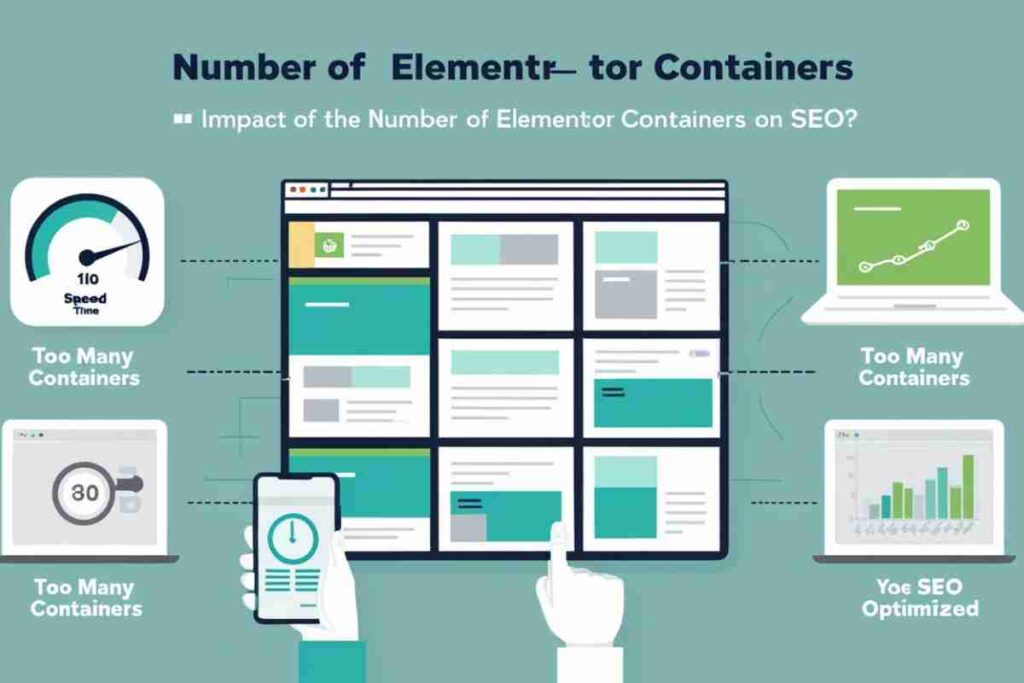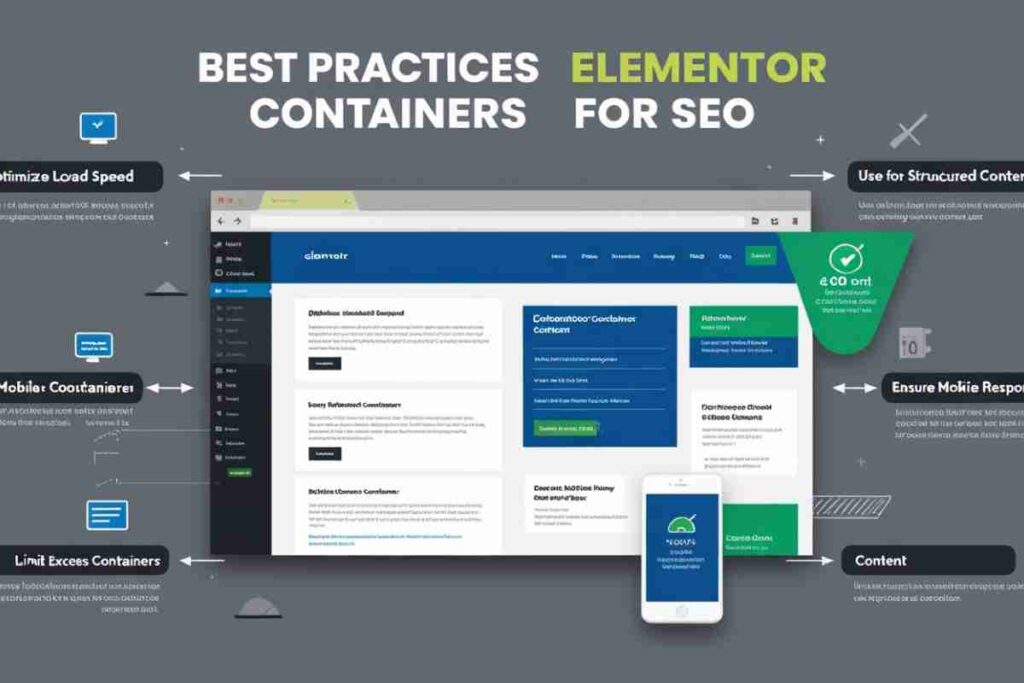When it comes to optimizing your website for SEO, many factors come into play, from page speed to content structure. One question that often arises among Elementor users is: Does the number of Elementor containers affect SEO?
While the concept of containers in Elementor may seem like a simple design tool, it can have a much bigger impact on your website’s performance and SEO rankings than you might think.
In this blog post, we will explore the role of Elementor containers, how their number affects your website, and whether adjusting them can improve SEO.
We will also address important concepts like flexbox, spacing between containers, and how Elementor containers work side by side, helping you make informed decisions to optimize your website.
What Are Elementor Containers?

To understand the impact on SEO, it’s important to first define what containers in Elementor are. In simple terms, a container is a structural element used to group content inside a page.
It allows web designers to manage the layout and styling of elements by providing a flexible area to work withinElementor containers are primarily used to organize sections and columns within a web page.
They help you control how content is displayed, from positioning to responsive behavior. Containers are also key in creating flexbox-based layouts that ensure content adapts well to different screen sizes.
How Do Elementor Containers Work?
In Elementor, a container can house various elements, such as text, images, buttons, or widgets. The primary purpose is to control the layout of these elements, either side by side (using columns) or stacked vertically.
Containers in Elementor can be set to different widths, alignments, and spacing options, depending on the layout you are aiming for.
For instance, when arranging elements side by side, Elementor allows you to place them within the same container and define their widths.
Additionally, the spacing between containers can be adjusted to create visually appealing layouts while maintaining control over the design.
While it’s tempting to create multiple containers for every section, doing so without consideration can increase page complexity and potentially slow down the load time, which impacts SEO.
Does the Number of Elementor Containers Affect SEO?

Now, let’s answer the burning question: Does the number of Elementor containers affect SEO? The short answer is: Yes, but it’s not just about the number of containers. It’s about how you use them.Here’s a breakdown of the ways Elementor containers can influence SEO:
Page Load Time and Performance
One of the primary factors in SEO is page load time. Search engines, especially Google, consider page speed as a critical ranking factor.
Too many containers on a page, especially if they are unnecessarily large or loaded with heavy content, can slow down page performance.
Elementor Containers tend to introduce a bit of extra HTML code into the page, which may not be an issue for a single or a few containers.
However, if your page includes a large number of containers—each with multiple elements—it can contribute to bloat and longer loading times.
This can negatively affect SEO rankings, as slow pages result in higher bounce rates and a poor user experience.
To optimize SEO, it’s essential to keep your page lightweight by using fewer containers and avoiding excessive nesting of elements. Where possible, opt for simpler designs with fewer containers that serve a clear functional purpose.
Mobile Responsiveness and Flexibility
SEO is not just about desktop performance—mobile-friendliness is equally important. Mobile-first indexing means that search engines prioritize mobile-optimized websites.
Since Elementor uses containers for layout, it’s important that these containers are responsive. Containers that stack and adjust properly on mobile screens can help improve the user experience and, in turn, your SEO ranking.
Using flexbox within Elementor allows you to create flexible layouts that adjust based on screen size. This ensures that your content remains readable and accessible on mobile devices, which is a key factor in SEO.
Overloading a page with containers side by side can lead to a poor mobile experience if not implemented with responsiveness and proper design in mind.
Accessibility and Structured Content
Another crucial aspect of SEO is accessibility. Properly structured content not only improves usability but also makes it easier for search engines to crawl and index your pages.
Containers can help organize content into digestible sections, making it easier for search engine bots to understand the hierarchy of your page.
If you use too many containers, however, it could lead to an overly complex structure that is difficult for search engines to interpret.
It’s important to ensure that your containers are being used logically to divide content, without overcomplicating the layout.
Content Hierarchy and SEO
Search engines rely on HTML structure to assess the importance of various elements on a page. By correctly using containers to organize content, you help search engines understand what information is most important.
However, creating unnecessary containers can disrupt the natural flow of the page hierarchy, making it difficult for search engines to understand your content.
Using containers effectively for headings, text, images, and other important SEO signals can provide a boost. But if containers are used excessively without purpose, it can negatively impact the overall readability and relevance of your page for search engines.
Best Practices for Using Elementor Containers for SEO

If you’re looking to improve SEO while using Elementor, here are some key best practices:
- Limit the Number of Containers: Avoid using too many containers for every element. Focus on keeping the layout clean and efficient. Use containers only when necessary for structure.
- Optimize for Mobile: Ensure your containers are responsive, especially when using the flexbox layout. Elementor’s flexbox features allow for better mobile-friendly designs.
- Use Containers for Hierarchical Structure: Make sure your containers are used to organize content logically. A clear structure will help search engines index your content more easily.
- Minimize Extra Markup: Excessive use of containers can add extra markup, which may affect load times. Keep the page lean and efficient.
- Leverage Elementor’s Built-in SEO Tools: Elementor offers SEO-friendly features such as custom tags, headings, and alt texts for images. Use them alongside containers for maximum effect.
Conclusion
The number of Elementor containers does impact SEO, but the key is how you use them. Too many containers can slow down performance and hurt mobile responsiveness, negatively affecting SEO.
When used strategically, containers help organize content, improve user experience, and support SEOSEO is multifaceted, and containers are just one factor.
Focus on a clean, efficient layout that is user-friendly and SEO-optimized to improve both performance and rankings.
FAQs
Does the number of Elementor containers impact SEO?
Yes, too many containers can slow down your website, affecting SEO, especially if they increase page load time.
How do containers affect mobile responsiveness in Elementor?
Containers can make a site more responsive when used correctly, but too many can cause layout issues on mobile devices.
Can I use containers side by side in Elementor?
Yes, you can arrange containers side by side, but make sure they are responsive and not overloaded to maintain good SEO.
How do containers in Elementor affect page load speed?
More containers can lead to a larger page size, which may slow down load time and negatively impact SEO.
Is using flexbox in Elementor containers SEO-friendly?
Yes, flexbox helps create flexible, responsive layouts, improving both mobile experience and SEO.
Should I use a container for every element in Elementor?
No, only use containers when necessary to avoid unnecessary complexity and performance issues.
Can Elementor containers improve site structure for SEO?
Yes, properly used containers can organize content, making it easier for search engines to index your page.
Does the number of Elementor containers affect SEO?
Yes, the number of Elementor containers can impact SEO. Too many containers can increase page load times, leading to poor performance and lower search engine rankings.



